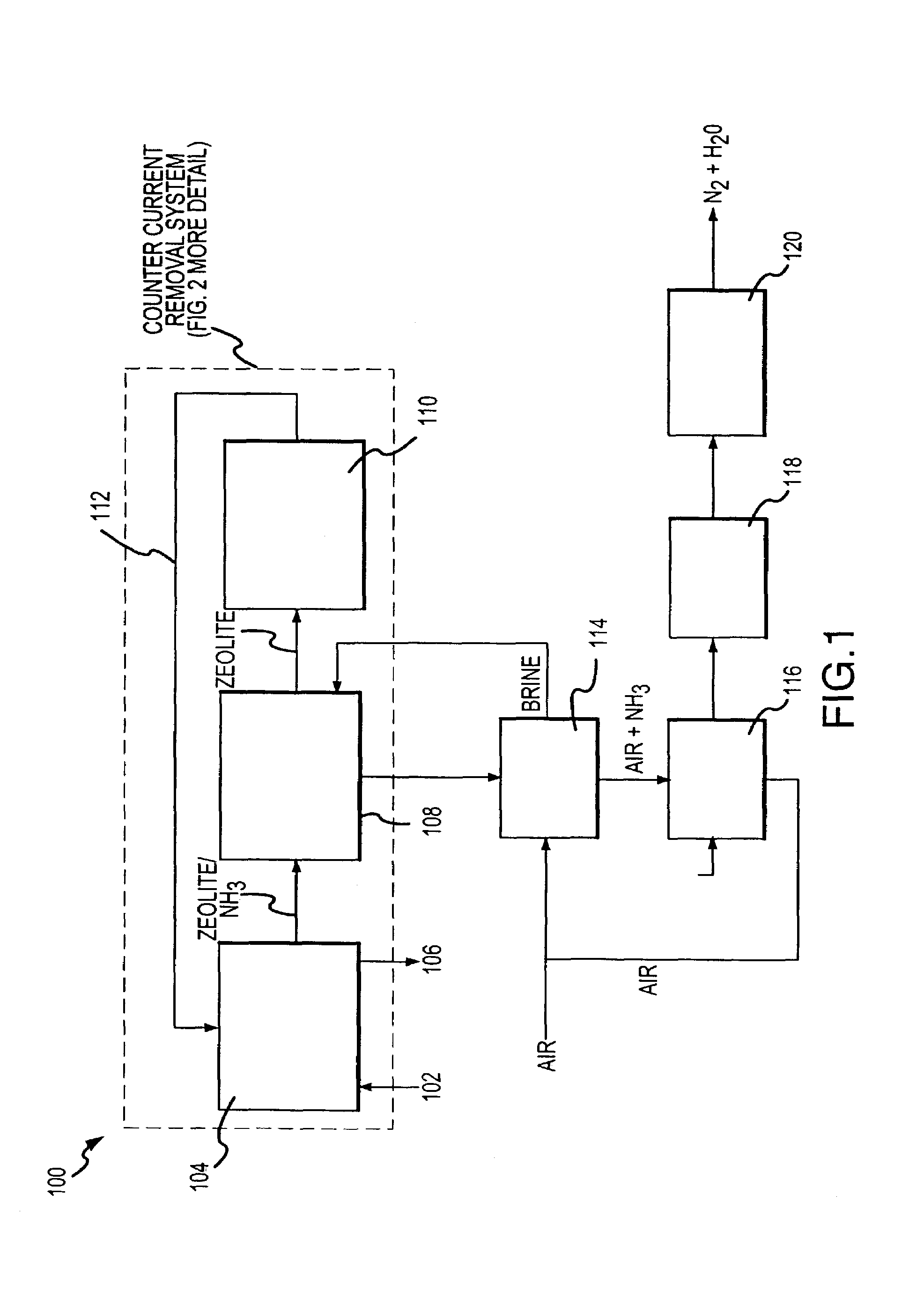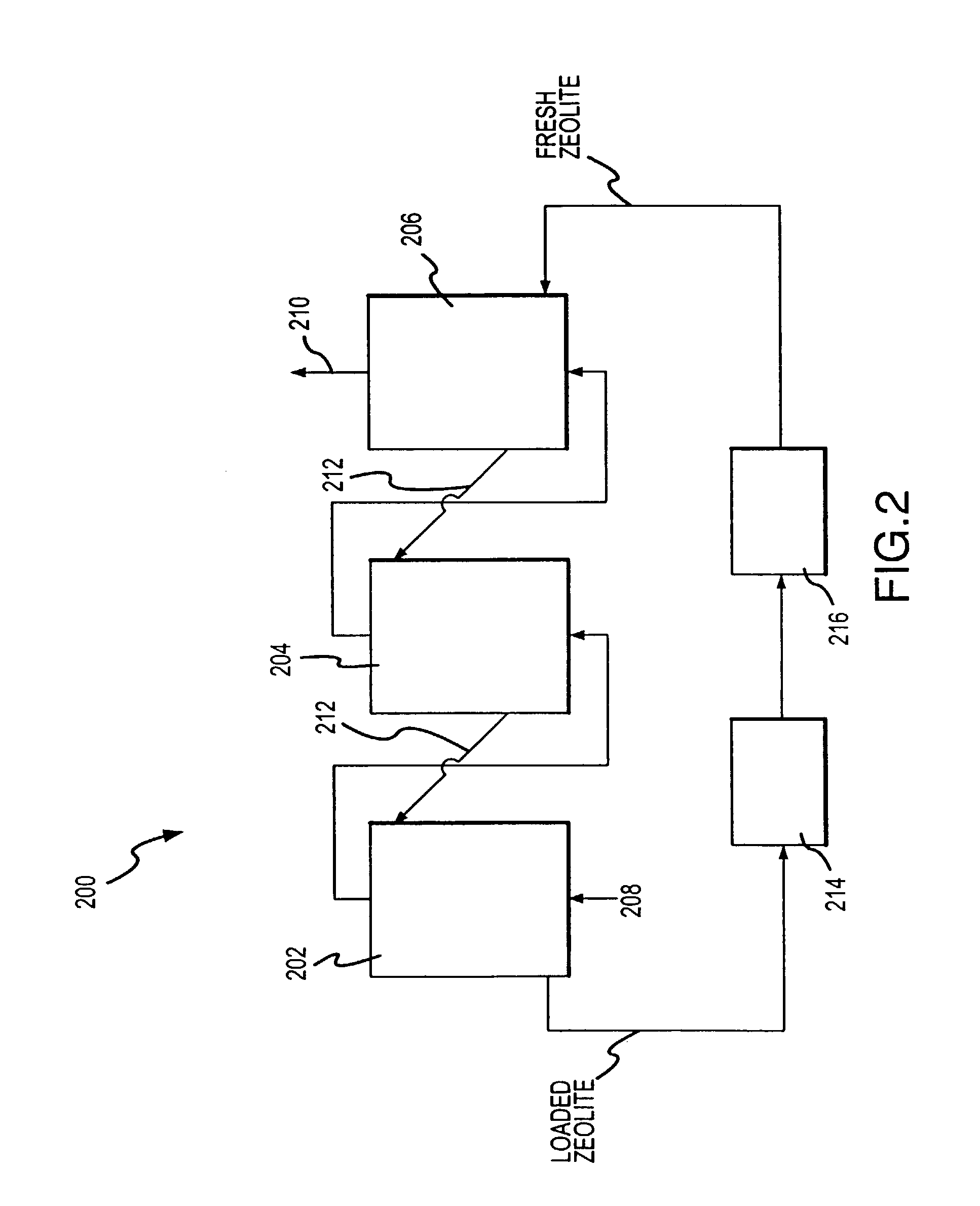Apparatus for removal and destruction of ammonia from an aqueous medium
a technology of ammonia removal and ammonia removal, applied in the direction of biological testing, chemical/physical processes, water/sewage treatment by ion exchange, etc., can solve the problems of ammonia contamination of water resources, limited fresh water utilization, and increased pollution of fresh water supplies
- Summary
- Abstract
- Description
- Claims
- Application Information
AI Technical Summary
Benefits of technology
Problems solved by technology
Method used
Image
Examples
example 1
Sodium Zeolite Absorption of De-mineralized Water / Ammonia Feed
[0083]Tables 2 and 3 show the results of ammonia absorption from an aqueous medium by two columns connected in series charged with regenerated sodium chloride zeolite. The feed solution was prepared using de-mineralized water and adding approximately 28 mg / L ammonia thereto. The feed solution was pumped in an up-flow configuration at a flow rate of approximately 1.5 liters per min (L / min).
[0084]The data shown in Table 2 shows that the concentration of ammonia in the effluent of column one began at 0.06 mg / L and concluded at 20.6 mg / L. The effluent exiting column two began at 0.03 mg / L and remained below the discharge level (1 mg / L ammonia) for about 450 minutes. At the completion of the test, the ammonia concentration in the effluent of column 2 was 8.1 mg / L. These results suggest that at the selected flow rate, an additional column of charged zeolite is necessary to ensure that the ammonia concentration in the effluent o...
example 2
Sodium Zeolite Absorption of High Ammonia Feed Containing Calcium, Magnesium and Potassium
[0091]Tables 6 and 7 illustrate that aqueous medium containing approximately 26.5 mg / L ammonia, 127 mg / L calcium, 36 mg / L magnesium, 31 mg / L potassium, and 8.8 mg / L sodium, can be effectively treated to remove ammonia using the apparatus and methods of the present invention. The aqueous medium was pumped up-flow through a two column system similar to the one described in Example 1. The solution was pumped at a flow rate of approximately 1.7 L / min for a total time of 435 minutes.
[0092]Tables 6 and 7 show that the concentration of ammonia in the column one effluent was approximately 20.9 mg / L and the concentration in the column two effluent was approximately 16.4 mg / L. As in Example 1, an additional column would have been useful for a more complete removal of the ammonia from the solution at that flow rate. The data also illustrates that calcium loads quickly onto the zeolite and that the majorit...
example 3
Sodium Zeolite Absorption of Ammonia from an Aqueous Medium Having High Concentrations of Calcium, Magnesium and Potassium
[0096]The data in Example 3 was prepared in a manner similar to that shown in Example 2, except that the flow rate through the two columns was approximately 1.5 L / min and the medium was run over the columns for a total of 430 minutes. As noted in Tables 8 and 9, the ammonium concentration of column one effluent was 19.7 mg / L, while the concentration of ammonium of column two was approximately 14.7 mg / L.
[0097]Note that the slightly decreased flow rate of the aqueous medium results in a higher absorption of ammonia by the zeolite as compared to the same ammonia loading performed in Example 2. Again, as described in Example 2, a third column of zeolite is required to keep the ammonia levels below 1 mg / L over the course of the experiment.
[0098]
TABLE 8Ammonia Loading onto Two Column Zeolite System - Col 1 Effluent (low flow)Col 1FlowBedmeq fedmed feqmeq fedmeqmeqmeq d...
PUM
| Property | Measurement | Unit |
|---|---|---|
| concentration | aaaaa | aaaaa |
| flow rate | aaaaa | aaaaa |
| concentration | aaaaa | aaaaa |
Abstract
Description
Claims
Application Information
 Login to View More
Login to View More - R&D
- Intellectual Property
- Life Sciences
- Materials
- Tech Scout
- Unparalleled Data Quality
- Higher Quality Content
- 60% Fewer Hallucinations
Browse by: Latest US Patents, China's latest patents, Technical Efficacy Thesaurus, Application Domain, Technology Topic, Popular Technical Reports.
© 2025 PatSnap. All rights reserved.Legal|Privacy policy|Modern Slavery Act Transparency Statement|Sitemap|About US| Contact US: help@patsnap.com



